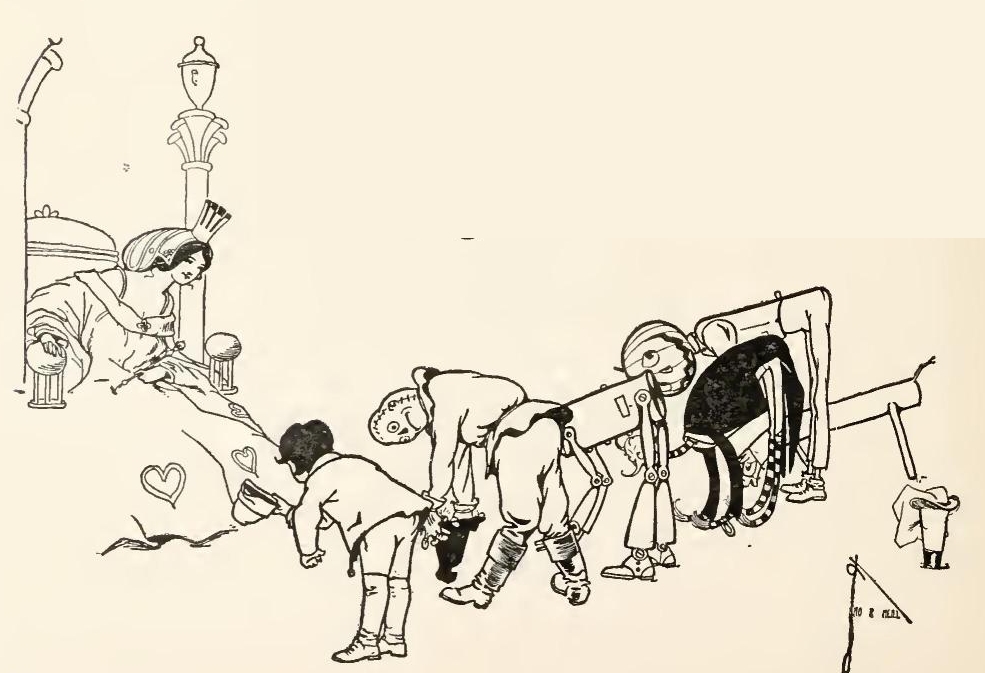
Moreover, in both The Wonderful Wizard and The Marvelous Land, all the most powerful, reliable, and capable characters, both good and evil, are girls: Dorothy, Ozma, Glinda, the Good Witch of the North, the Wicked Witches, Mombi, and Jinjur. For comparison, take the Emerald City’s previous figures of power: the Wonderful Wizard is a weak conman from Omaha who stole the throne (and only with the female Mombi’s assistance), the army is a single man (Omby Amby) who is scared of women, and the Scarecrow is a clownish ruler who gets made a fool of by a little girl (who wears lettuce on her shoes) in the funniest scene in the novel. The lesson might be that Jinjur is wrong because she inverts the relationship of oppression, whereas Ozma is right because she wants women and men to have equal rights. Many aspects of The Marvelous Land defy simple interpretation.
In the real world, Baum supported women’s rights and was related to the activist Matilda Joslyn Gage. To quote one source: “Baum’s choice of a girl instead of a boy for this central role [that is, for Dorothy] is significant in several respects. Many of the rulers and protagonists in Oz were female. In addition to Dorothy and Glinda, later books introduce Ozma and Lurline, both benevolent rulers. Frank Baum was committed to the cause of women’s rights. Both his wife and mother-in-law campaigned for women’s suffrage. […] As the editor of the Saturday Pioneer, Baum published political tracts written by his mother-in-law, and the paper endorsed women’s suffrage in South Dakota” (Gretchen Ritter, 178). This accounts for the frequency of powerful and capable girls and women in his fiction. At risk of leaving you with too positive an impression, I will remind you that Baum was also a racist who advocated genocide. And who also wrote a sort of sequel to The Marvelous Land entitled The Woggle-Bug Book that is so racist it has, with good reason, rarely been reprinted.
Jinjur’s wish for a girl to rule the Emerald City comes true. The Scarecrow repeatedly indicates he would prefer not to be the king, and the characters grant that Jinjur has just as much right to the throne as he does, as both came to power illegally. The Wizard somehow took over after the death of the previous monarch, Pastoria. In the most shocking twist of the novel, it turns out that Tip is Pastoria’s long-lost heir, Princess Ozma, whom Mombi has magically turned into a boy!
At first, Tip rejects his birth identity as a girl. Glinda tells him, “[Y]ou were born a girl, and also a Princess; so you must resume your proper form, that you may become Queen of the Emerald City.” Tip replies, “I want to stay a boy, and travel with the Scarecrow and the Tin Woodman, and the Woggle-Bug, and Jack—yes! and my friend the Saw-Horse—and the Gump! I don’t want to be a girl!” (272). However, the Tin Woodman and Scarecrow assure Tip that girls are just as good as boys—another intriguing interaction with the Army of Revolt plot—and Mombi performs a vividly described ritual to turn him into a girl. Although Tip has changed into “a young girl, fresh and beautiful as a May morning” (276), she reassures her friends she is still the same person she always was, only different. The ending has Ozma arrest (and forgive) Jinjur and then live out her days perfectly happy. It is as if a boy would have failed before Jinjur, so Tip has to be transmuted into Ozma so that Jinjur’s dream of a society led by a woman can come true.

In effect, The Marvelous Land of Oz is a fantastical coming-of-age story where a young, irresponsible boy matures into a powerful girl. I am tempted to call this a transgender narrative! Because it is. So that is what they meant by going over the rainbow. However, Ozma’s enchanted transition is not an affirmation of identity but almost the opposite: Ozma is AFAB and forced to return to girlhood even though there is no obvious reason this is necessary to rule the Emerald City. On the other hand, Ozma has no idea she began as female until Mombi reveals the truth of her conspiracy with the Wizard, so Ozma might as well have begun as a boy. Yet others seem to read the story as a metaphor for a trans girl AMAB who has to rediscover her true nature, which was evident from the start but concealed from her. I am not sure I buy the trans-positive reading. Tip explicitly does not want to be a girl. But for the sake of all our mental health, I will cede the point to the number of trans people I have found online who prefer this metaphorical reading. So I will assume things are fine. (But are they though)